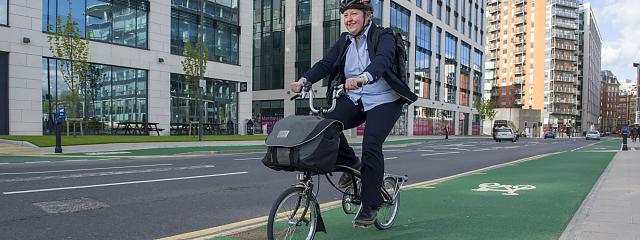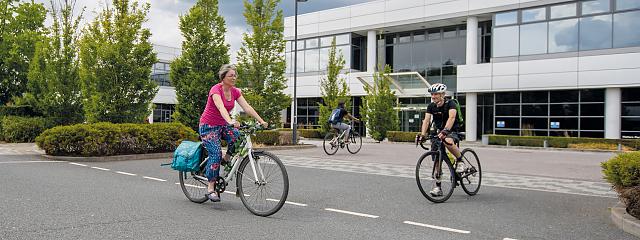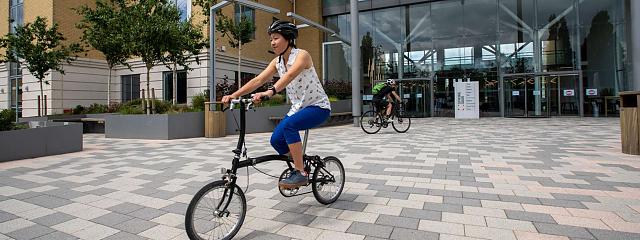
How much carbon can you save by cycling to work?
How much carbon can you save by cycling to work?
The UK has committed to net zero by 2050. This doesn’t mean an attempt to emit no carbon, but it does require a huge cut in those emissions.
According to government research, transport is the biggest contributor to the UK’s carbon emissions, with surface traffic contributing 27%. Private cars and taxis make up most of this. Most journeys by car are less than 10km – a distance that’s easily cyclable for many people, especially when you factor in e-cycles.
In fact I heard the shocking statistic that there are 250,000 journeys by car in Birmingham of under 1 mile on every work day in an episode of the active travel podcast Streets Ahead.
At the same time, employees’ largest contribution to carbon emissions is their commute, with most driving: 68% according to government findings. Net zero requires society-wide change and commitment from governments. But one thing we can do as individuals is to cut down on those short journeys by car. Employers can also get on board by providing a work environment that makes it easy to cycle.
Carbon-free commuting?
There’s no such thing as carbon-free travel. But not all modes of transport were created equal when it comes to carbon emissions. Cycling emits the least amount of carbon, even than walking. This is more so for e-cycles. This might sound surprising, but there’s research to back it up.
The European Cyclists’ Federation (ECF) calculated and compared the carbon dioxide emissions of cycling, driving a car or taking the bus, taking into account manufacturing, fuelling and number of passengers.
The research shows that the car remains Europeans’ preferred mode of transport. It is also the least environmentally friendly: driving a car emits about 271g CO2 per passenger-kilometre. Taking the bus cuts those emissions by more than half, pumping 101 g of CO2 per passenger-kilometre into the air. This is largely because buses hold a lot more passengers.
But if you really want to cut those emissions, you should invest in a bike. Riding a conventional bike accounts for just 21g of CO2 emissions per kilometre. This compares to 56g for walking and just 14.8g for e-cycles. How can that be the case, though? Fuel. But conventional bikes don’t require fuel, unlike e-cycles, I hear you cry. But cyclists do, as do walkers.
According to the ECF research, the production of a bicycle sets you back only 5g of carbon per kilometre travelled. The rest comes from the food the cyclist need to eat to power their ride. The power assist on an e-bike means the rider doesn’t need to eat as much so saves more carbon. Walkers, on the other hand, require more food to travel the same distance as a cyclist.
These figures are all based on the average European diet, which still includes quite a lot of meat. So a vegetarian or vegan diet would keep even more carbon out of the air.
This research didn’t look at trains, but a government report says that on average, UK trains account for 41g of C02 per passenger-kilometre.
Swapping just one trip per day from driving to cycling for 200 days of the year would save half a tonne of carbon dioxide over the course of a year
Carbon savings
But what does this mean for you and your commute? Researchers led by Dr Christian Brand, an associate professor in transport, energy and environment at the University of Oxford, observed 4,000 people living in London, Antwerp, Barcelona, Vienna, Orebro, Rome and Zurich over a two-year period.
Participants recorded what trips they made every day, including why they were travelling, how far and what mode they used. The researchers calculated the carbon footprint for every trip made.
They found that swapping just one trip per day from driving to cycling for 200 days of the year would save half a tonne of carbon dioxide over the course of a year. This means that if you were to swap your drive to work for cycling you would drastically reduce your carbon footprint.
If you’re anything like me, though, ‘half a tonne of carbon’ means very little in practical terms. Dr Brand explained this is equivalent to a one-way flight from London to New York. Put like that it sounds impressive.
Researchers found that shifting just one trip from car to cycle per day saves the average person 3.2kg of carbon. According to Dr Brand this is “equivalent to the emissions from driving a car for 10km, eating a serving of lamb or chocolate, or sending 800 emails”. I don’t know about you, but I quite like the idea of carbon offsetting my chocolate habit …
This shows that small changes can add up – especially if we act collectively. As Dr Brand said: “If just one in five urban residents permanently changed their travel behaviour in this way over the next few years, we estimate it would cut emissions from all car travel in Europe by about 8%.” That goes quite a long way towards our net zero commitments.
Not everyone can cycle all the way to work, but again, every little counts. Remember how much carbon is saved by taking a bus or train rather than driving? Combining cycling with modes of public transport will also significantly reduce your carbon footprint. These figures are based on 40% capacity, too, so the more people using each train or bus, the lower those carbon emissions per passenger-kilometre will be.
E-cycles can also help extend the distance you can commute, taking some of the effort out of the kilometres and any hills. As we’ve already seen, e-cycles are even lower carbon than non-assisted cycles. If you want to try out an e-cycle, and you live in Manchester, Sheffield, Luton and Dunstable or Leicester, check out our Making cycling e-asier project for free one-month loans of an e-cycle.
Carbon-friendly employers
If you’re an employer looking to make your workplace more environmentally friendly, supporting staff to cycle to work is a big step forward. A much smaller carbon footprint isn’t the only benefit. There’s plenty of research showing that employees who cycle to work are happier, healthier and more productive. It reduces absenteeism and also improves people’s sense of wellbeing.
Cycling UK has all the advice, resources and expertise you need to make your workplace supportive of cycling. Our Cycle Friendly Employer accreditation is the international benchmark for active travel culture and infrastructure in the workplace. You can find out more about how it works in our comprehensive guide.
If you’re an employee who’s trying to get your employer interested in helping you and your colleagues to cycle to work, this is a great place to start.
Remember that this is all cumulative – the more of those short journeys you cycle the more carbon you save. This applies to all those who don’t work, too. Cycling to the shops, a local café, a friend’s house – any short journey you’d usually drive – will all reduce your carbon footprint, making us all that bit kinder to the environment.
Government action
There is, however, only so much we can do as individuals. If the UK – as well as other countries around the world – are to hit net zero targets then it will require changes on a society-wide basis, and that requires wholesale commitment from governments.
On 28 June, the Climate Change Committee, the UK Government’s statutory advisors on climate, published its annual report. It offered a damning assessment of the Government’s failure to reduce car dependency. It also confirmed what Cycling UK has claimed for years: that current funding is far too low for Government to meet its targets to double cycling and increase walking in England.
The reality is, we know distance isn’t the only, or even the main, barrier to cycling to work – it’s a lack of safe space on our roads. And that’s something only Government – both local and national – can solve by stepping up and providing funding for safe cycling infrastructure. Where this is provided, cycling increases. You only need to look to the City of London, where cycling has become the most popular mode of transport.
This is why Cycling UK is calling on UK Governments to rebalance funding for transport, directing investment away from more polluting forms of transport towards cycling and walking. Our Drive less, cycle more campaign is challenging governments across the UK to reduce motor traffic to allow more people to cycle.
Keir Gallagher, Cycilng UK’s campaigns manager, commented: “When it comes to cycling to work, the evidence is clear: build safe, protected cycling infrastructure along key commuter routes, and people from all walks of life will jump at the chance to say goodbye to morning congestion and embrace rolling into work feeling fresh and energised.
“If UK Governments wants to reduce carbon emissions and reach its climate targets, it must rebalance transport investment to tackle car dependency and offer people genuine sustainable transport options for their commute, be that cycling, walking, public transport, or a combination of all three.”
Safe infrastructure is hugely important to getting more people cycling to work, but it’s not the whole picture. We also need a change in attitudes and behaviour. This is why Cycling UK’s projects such as Making cycling e-asier, community cycle clubs, Access Bikes and Rural Connections, all of which help break down barriers to cycling, and the Big Bike Revival – which helps to get and keep cycles on the road – are also crucial.
Rebalancing transport funding
The Government’s current transport plans include spending billions on motorways and major A roads, while cutting investment in cycling and walking infrastructure by 75%. Cycling UK is calling on government to redress this imbalance. You can get involved by adding your voice to our message.













